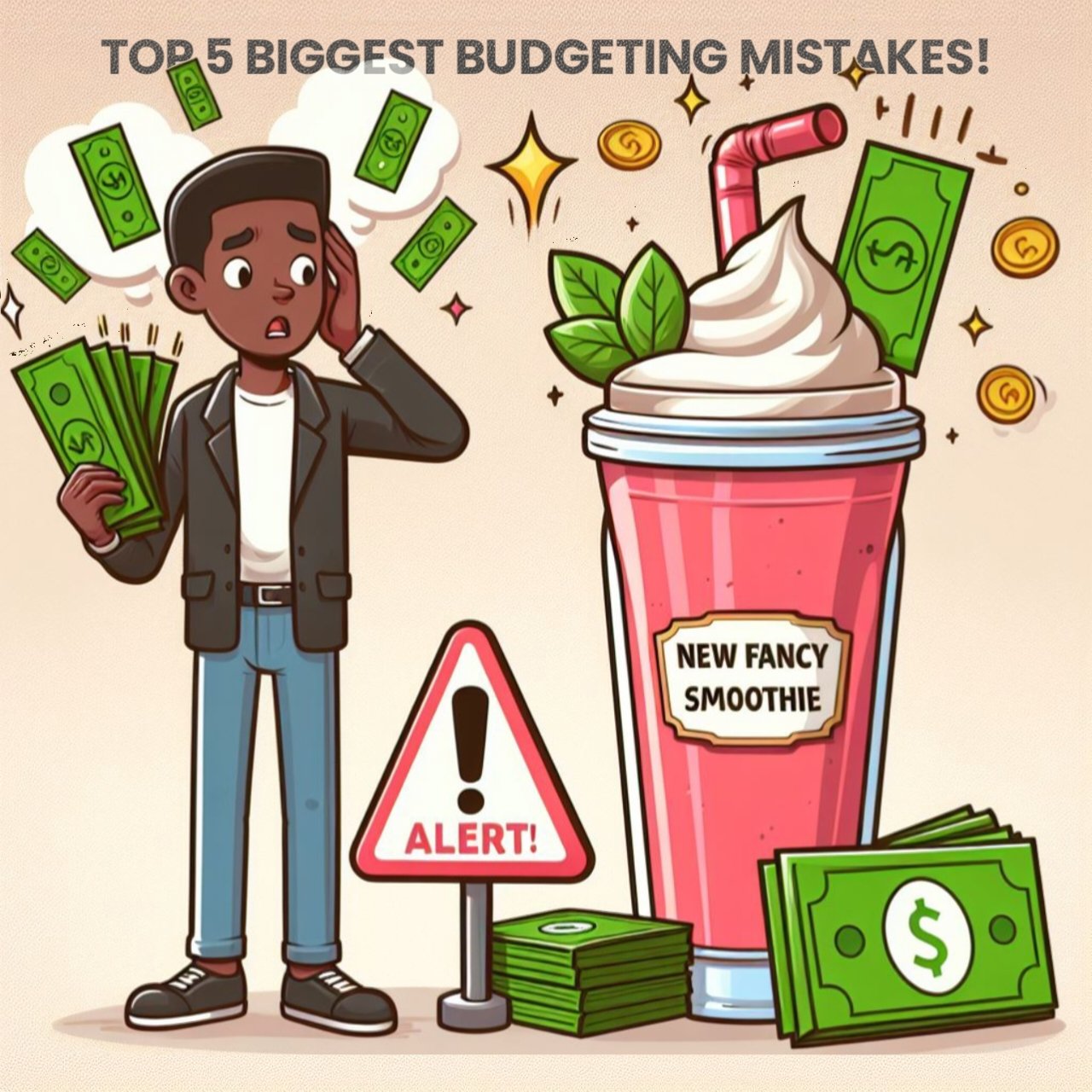Introduction
Ever reach the end of the month with your wallet feeling lighter than a feather on a windy day?
You’ve budgeted, you’ve planned, you’ve even sacrificed that extra avocado toast (maybe)… but your bank account keeps singing the same sad, empty tune.
The truth is, even the most well budget can be secretly framing sneaky importers, silently sliding money from your pockets like financial pocket picker. These hidden budget busters aren’t always screaming sirens warning of impending financial doom. They hidden in the shadows, pretend as harmless habits or seemingly reasonable expenses. But the cumulative effect? Financial assassination. ☠️

Ready to reveal these budget vampires and reclaim your financial freedom? Buckle up, because we’re about to expose the 5 most common (and surprisingly sneaky!) budgeting mistakes that are killing your wallet, one step at a time. We’ll not only show the problem, but also provide proven-tested solutions to vanish these budgeting thief for good. So, let’s crack open your financial ledger and slay the budgeting beasts that have been feasting on your hard-earned cash! ️
Are you ready to say goodbye to empty wallets and hello to financial freedom? Then strap in for this eye-opening, wallet-saving expose!
Subscription and Membership
Unlocking the Recurring Fees Eating Away at Your Cash Flow.
Raise your hand if you’ve ever reached the end of the month with your bank account looking like a deflated balloon after a birthday party. Guilty as charged, right? We’ve all been there, victims of a hidden financial foe: subscription suckerpunch.
It’s not the big-ticket expenses that usually get us. Nope, it’s the sneaky little subscriptions, gym memberships we haven’t used in months, streaming services we barely watch, apps we downloaded on a whim and forgot about. They’re like vampire bills, silently siphoning away our hard-earned cash, one recurring charge at a time.

Think about it: that $10-a-month streaming service, multiplied by a few, adds up fast. Suddenly, it’s enough for a fancy takeout dinner or a concert ticket. And it’s not just entertainment subscriptions. Meal kits you don’t always use, fitness trackers gathering dust, even unused software subscriptions you signed up for in a fit of “I might need this someday” fever – they all contribute to the financial drain.
So, how do we break free from this subscription suckerpunch? Here’s the three-round knockout plan:
Round 1: The Audit of Doom (But Actually Awesome)
It’s time for a financial reckoning. Pull up your bank statements, scan your email for subscription confirmations, and ruthlessly assess every single recurring charge. Ask yourself:
- Am I actually using this? Be honest! That language learning app collecting virtual cobwebs doesn’t count.
- Is it worth the cost? Could I find a cheaper or free alternative?
- Do I genuinely enjoy it? Sometimes, convenience subscriptions become emotional anchors we need to cut loose.
Round 2: The Unsubscribe Uprising
Armed with your audit results, go on a glorious unsubscribe spree! Click “cancel” with the righteous fury of a thousand forgotten dollars. Be warned: some companies try to guilt you with hidden fees or manipulative tactics. Stand firm, you’ve got this!
Round 3: The Budget Barricade
Now, put up some financial defenses. Set spending limits on non-essential categories like subscriptions, track your expenses, and automate savings transfers. This makes it harder for those sneaky subscription fees to sneak back in.
Remember, breaking free from the subscription suckerpunch isn’t just about saving money, it’s about taking control of your finances. It’s about saying “no” to mindless spending and “yes” to experiences, goals, and financial freedom. So, go forth, audit your subscriptions, unsubscribe with fervor, and build that budget barricade! Your wallet will thank you.
Treat yourself to a subscription you genuinely love and use, the one that brings you joy or value. The key is being mindful and intentional about your choices. Happy unsubscribing!
Latte Leak
How Daily Indulgences Sabotage Your Savings Goals, One Sip at a Time.
Ah, the humble latte. It fuels our workday hustle, perks up our afternoon slumps, and whispers sweet nothings about creamy deliciousness. But here’s the not-so-sweet truth: those seemingly harmless daily indulgences can silently chip away at your savings goals, turning them into a sad puddle of what-ifs.

Think about it: a fancy coffee here, a smoothie there, lunch out with coworkers – they might seem like tiny expenses in the grand scheme of things. But multiplied by 5, 10, or even 20 days a month (yikes!), they can drain your budget faster than you can say “venti caramel macchiato.”
1. Don’t get me wrong, I’m not advocating for a life devoid of caffeine-fueled joy. But being mindful of how these “little leaks” can impact your financial goals is crucial. Here’s how to plug the latte leak and keep your savings on track:
2. Track Your Coffee Habit: Knowledge is power, my friends. For a week, track every coffee purchase you make – the price, the size, the fancy add-ons. Seeing the total number might just be the wake-up call you need.
3. Unleash the Inner Coffee Connoisseur: Who says good coffee has to be expensive? Explore local cafes, brew your own at home (you might be surprised by your barista skills!), or even try budget-friendly alternatives like tea or cold brew.
4. Embrace the DIY Spirit: Pack your lunch, whip up quick and healthy snacks at home, and swap fancy takeout for budget-friendly home-cooked meals. You’ll be amazed at how much money (and calories) you can save.
5. Set Realistic Goals: Don’t go cold turkey if daily coffee is your lifeline. Start by cutting back one or two purchases a week, then gradually increase the frequency. Small changes add up in the long run.
6. Reward Yourself Wisely: Celebrate your progress! Hitting your savings goals deserves a pat on the back, but reward yourself with something meaningful and non-monetary – a day in nature, a movie night with friends, or that new book you’ve been eyeing.
Remember, breaking the latte leak isn’t about deprivation, it’s about conscious indulgence. Choose your treats wisely, track your spending, and find creative ways to save. It’s like building a financial dam against a stream of coffee cups – every small action helps turn your leaky budget into a steady reservoir of savings.
So, go forth, embrace the DIY coffee spirit, and watch your financial goals flourish, one delicious (and budget-friendly) sip at a time!
Bonus Tip: Get your friends and family on board! Start a coffee challenge together, share budget-friendly recipe ideas, and motivate each other to stay on track. Support is key to making any change, and financial health is definitely worth cheering each other on for.
Planning Paradox
Why Your Shiny Budget Might Actually Be Your Worst Enemy.
We’ve all heard it: budgeting is the key to financial success. You diligently craft spreadsheets, categorize expenditures, and track every penny with military precision. But here’s the plot twist: sometimes, a micromanaged budget can become your very own financial villain, holding you back instead of propelling you forward.
Think of it like an overcooked lasagna – delicious in theory, but one bite too many leaves you feeling heavy and uncomfortable. That’s what a rigid budget can do to your financial mojo. Let’s explore how:
1. The Fun-Sucking Monster: A budget that strangles every impulse purchase can morph into a joyless warden. No spontaneous movie nights? No occasional splurge on a fancy dinner? Suddenly, your financial plan feels like a prison sentence, leading to frustration and the urge to rebel (hello, midnight ice cream raid!).
2. The Overestimation Trap: We like to believe we’ll stick to our perfectly planned budgets, but life happens. Unexpected expenses arise, leaving your meticulously calibrated spreadsheet in tatters. The result? Frustration, guilt, and a sense of failure that can derail your entire financial journey.
3. The Flexibility Famine: Remember, budgets are tools, not straitjackets. Rigid planning can blind you to opportunities, like grabbing a discounted gym membership or snagging a last-minute travel deal. Being overly fixed on your plan can make you miss out on unexpected financial wins.
So, how do we escape the Planning Paradox and embrace a budget that works with us, not against us? Here are some tips:
1. Build in Buffer Zones: Allocate a small “wiggle room” in your budget for those unplanned life moments. Don’t let a surprise car repair send your financial plan into a tailspin.
2. Celebrate Progress, Not Perfection: Small wins matter! Reward yourself for hitting milestones, not just achieving budgeting nirvana. This keeps your financial journey positive and prevents burnout.
3. Embrace Rolling Reviews: Your budget isn’t set in stone. Review it regularly, adapt to changing needs, and don’t be afraid to adjust. A flexible budget is a happy budget.
Remember, the goal of budgeting isn’t to become a financial robot. It’s about gaining control of your money, not letting it control you. Find the sweet spot between planning and flexibility, and you’ll discover a budget that empowers, not imprisons. Go forth, tweak your spreadsheets, and embrace a budget that celebrates the journey, not just the destination.
Get creative with your budgeting! Use apps, trackers, or even colorful charts to make the process fun and engaging. The more you enjoy managing your money, the more likely you are to stick with it.
Let’s turn that Planung Paradox into a Financial Forté! Happy budgeting, friends!
Emergency Evasion
The False Security of Neglecting Your Rainy Day Fund.
Picture this: your phone explodes into a million pixels of despair. Your fridge hums an empty lullaby. Your car throws a diva tantrum on the busiest highway ever. Life can turn from sunshine to stormy chaos in a heartbeat, and when it does, you need one thing – a financial umbrella.

Except, what if you haven’t bothered packing one? Turns out, avoiding an emergency fund feels like a good idea right up until the moment you desperately need it. And trust me, friends, that moment will come. Trust the universe, trust fate, trust your clumsy-prone coffee mug – something unexpected will test your financial fortitude.
So, why do we skip building this financial safety net?
1. The “It Won’t Happen to Me” Fallacy: We like to believe misfortune skips our address. Until it doesn’t. Medical bills, job loss, appliance meltdowns – they’re not pleasant to consider, but ignoring them doesn’t make them disappear.
2. The Instant Gratification Trap: Savings seem distant and abstract, while that new gadget or fancy dinner tantalizes right now. But trust me, the peace of mind that comes from knowing you can handle unexpected bumps is way more satisfying than fleeting retail therapy.
3. The Small Amount Excuse: “I can only save a few bucks each month, what’s the point?” Every saved penny is a financial superhero in training. Small amounts, consistently stashed away, have a magical way of multiplying over time. Remember, Rome wasn’t built in a day (and its emergency fund probably wasn’t either).
So, how do we escape the temptation of emergency evasion and build a rainy day fund that can weather any storm?
1. Start Small, Dream Big: Even $10 a week adds up. Automate those little transfers, watch them grow, and celebrate your progress!
2. Challenge Yourself: Set a savings goal, even if it seems ambitious. Seeing a visible target gives you something to strive for and makes saving feel less like a chore.
3. Find Hidden Gems: Track your spending and cut back on unnecessary expenses. That daily latte habit could be funding your future emergency fund instead!
Remember, an emergency fund isn’t about deprivation, it’s about taking control and avoiding financial heartbreak. It’s a safety blanket woven with peace of mind and the power to say “bring it on!” to life’s inevitable curveballs.
So, grab your financial umbrella, stash some savings away, and face the storms with confidence. Your future self will thank you for it!
Bonus Tip: Emergency funds are for emergencies, not everyday expenses. Don’t dip into it unless you absolutely have to. But when you do, remember it’s not a failure, it’s your rainy day fund doing its job!
Let’s ditch the emergency evasion and build financial fortresses, one superhero penny at a time!
Lifestyle Lie
Breaking Free from the Comparison Trap and Embracing Budget Bliss on Your Terms.
Raise your hand if you’ve ever scrolled through social media and felt a sudden pang of financial inadequacy. That perfectly curated vacation spread, the effortlessly chic apartment, the “I just woke up like this” glow that screams endless brunches and designer sprees. We’ve all been there, friends, victims of the Lifestyle Lie: the illusion that everyone else is living this picture-perfect, wallet-busting life, and we’re somehow falling short.
But here’s the truth bomb: most of that Insta-worthy perfection is carefully staged, heavily filtered, and often financed on credit cards that sing the blues in the dark. And even if it’s real, who says their definition of happiness has to be yours? Comparing your budget to someone else’s highlight reel is a recipe for financial frustration and missed opportunities.
So, let’s break free from the Lifestyle Lie and embrace Budget Bliss: a state of financial well-being where you spend on what matters to you, not what the algorithm dictates. Here’s how:
1. Define Your Own “Rich”: Forget mansions and yachts. What makes you rich? Travel? Creative hobbies? Time with loved ones? Figure out your priorities and build your budget around them, not someone else’s curated feed.
2. Track Your Joy, Not Just Your Numbers: Budgeting isn’t just about spreadsheets and deprivation. Track what spending brings you genuine happiness, not just guilt. Maybe that fancy coffee fuels your morning hustle, or that weekly pottery class sparks your creativity. Invest in experiences that add joy, not just zeros to your bank account.
3. Embrace DIY Magic: You don’t need a five-star spa to unwind. Discover the magic of budget-friendly self-care routines, homemade meals with friends, or exploring hidden gems in your own city. Creativity and resourcefulness are your secret weapons in the fight against the Lifestyle Lie.
4. Celebrate Small Wins: Hitting your savings goal, ditching a unnecessary subscription, cooking a delicious meal at home – these are victories! Celebrate your progress, no matter how small. Building financial well-being is a marathon, not a sprint, so savor the milestones along the way.
5. Unsubscribe from the Comparison Game: Stop scrolling through feeds that make you feel inadequate. Follow people who inspire you, not envy you. Fill your social media with positive vibes and financial role models who support your journey, not fuel the Lifestyle Lie.
Remember, budget bliss isn’t about living on ramen noodles or depriving yourself. It’s about consciously choosing where your money goes and aligning your spending with your values. It’s about living a life that’s rich in happiness, experiences, and the freedom to chase your own dreams, not someone else’s filtered fantasies.
So, go forth, ditch the comparison trap, and build your own version of Budget Bliss. Cook that gourmet meal at home, explore your city on a bike, invest in that passion project. Your financial happiness, and a life less ordinary, awaits!
Find your Budget Bliss tribe! Connect with friends or online communities who are on a similar financial journey. Sharing tips, celebrating successes, and supporting each other makes the path to financial freedom even more fun and motivating.
Let’s rewrite the narrative, one budget win at a time!
Conclusion
So, there you have it, folks! Five budgeting blind spots lurking in the shadows, ready to drain your wallet and sabotage your financial goals. But remember, you’re armed with the knowledge and the power to fight back! Unmask these budget vampires, one by one, with the tips and tricks we’ve shared.
Unsubscribe from the subscription suckerpunch, break free from the latte leak, and escape the planning paradox. Build your emergency fortress, ditch the Insta-worthy fallacy, and embrace budget bliss on your own terms. This isn’t a crash diet for your finances, it’s a sustainable lifestyle makeover. It’s about making conscious choices, finding joy in small wins, and celebrating your progress every step of the way.
Your financial journey is unique, so don’t compare your budget to someone else’s highlight reel. Craft a plan that works for you, your values, and your dreams. Embrace the DIY spirit, celebrate your wins, and find your Budget Bliss tribe. Together, let’s rewrite the narrative and prove that financial freedom isn’t just a dream, it’s a delicious, joyful, and totally achievable reality. Now, go forth and conquer those hidden budget busters! Your future self will thank you for it.
And hey, if you stumble along the way, don’t fret! Budgeting is a journey, not a destination. Just pick yourself up, dust yourself off, and keep moving forward. Remember, even the smallest progress matters. So, cheers to your financial victories, big and small!
Let’s turn this budgeting battlefield into a financial fiesta!
FAQs about Budgeting Blind Spots
Q: How do I know if I’m falling victim to one of these budgeting blind spots?
A: Take a close look at your spending habits! Do you have a bunch of subscriptions you barely use? Do you find yourself making daily coffee runs that add up? Are you living beyond your means, trying to keep up with a lifestyle you see online? If you answered yes to any of these, you might be falling victim to one or more of these blind spots.
Q: What’s the best way to break free from a budgeting blind spot?
A: The first step is awareness! Once you identify the blind spot, you can start taking steps to address it. For example, if you’re struggling with subscription overload, audit your subscriptions and cancel the ones you don’t use. If you’re addicted to daily lattes, try making coffee at home or finding cheaper alternatives. And if you’re comparing your budget to others, remember that everyone’s financial situation is different. Focus on your own goals and what works for you.
Q: I need help sticking to my budget! Any tips?
A: There are lots of things you can do to make budgeting easier and more enjoyable! Try using a budgeting app or spreadsheet to track your income and expenses. Set realistic goals and celebrate your successes along the way. Find creative ways to save money, like cooking at home instead of eating out or taking advantage of free or low-cost activities in your community. And don’t be afraid to ask for help! Talk to friends, family, or a financial advisor for support and guidance.
Resources
Books:
- I Will Teach You to Be Rich by Ramit Sethi: https://www.iwillteachyoutoberich.com/
- The Automatic Millionaire by David Bach: https://bestbookbits.com/wp-content/uploads/2019/03/The-Automatic-Millionaire-by-David-Bach.pdf
- Broke Millennial by Erin Lowry: https://brokemillennial.com/
Websites:
- NerdWallet: https://www.nerdwallet.com/
- The Penny Hoarder: https://www.thepennyhoarder.com/make-money/
- Mint: https://mint.intuit.com/
- Financial Samurai: https://www.financialsamurai.com/
- Mr. Money Mustache: https://www.mrmoneymustache.com/
Podcasts:
- ChooseFI: https://www.choosefi.com/listen/choose-fi-podcast/
- Afford Anything: https://affordanything.com/podcast/
- Clark Howard Show: https://clark.com/podcasts/
- Stacking Benjamins: https://www.stackingbenjamins.com/
- The Dave Ramsey Show: https://www.ramseysolutions.com/
Budgeting Apps:
- Mint: https://mint.intuit.com/: https://mint.intuit.com/ – Free, automatic expense tracking, budgeting tools, and bill reminders.
- YNAB (You Need A Budget): https://ynab.com/: https://ynab.com/ – Paid, zero-based budgeting method with a learning curve, but powerful for committed users.
- Personal Capital: https://www.personalcapital.com/: https://www.personalcapital.com/ – Free, tracks investments, net worth, and spending, good for a holistic financial picture.
- PocketGuard: https://www.pocketguard.com/: https://www.pocketguard.com/ – Free, visualizes spending and automatically categorizes transactions, good for quick insights.
- EveryDollar: https://everydollar.com/: https://everydollar.com/ – Free, simple and visual envelope budgeting method, good for beginners.
Bonus Tips:
- Find an app or tool that works for you: Experiment with different options until you find one that fits your needs and preferences.
- Automate as much as possible: Set up automatic transfers to savings accounts or investments to make saving effortless.
- Track your progress: Regularly review your budget and spending habits to stay on track and celebrate your achievements.
- Seek support: Don’t be afraid to ask for help from a financial advisor or counselor if you need extra guidance, you can also contact us and you can also rate this blog-post at below.

